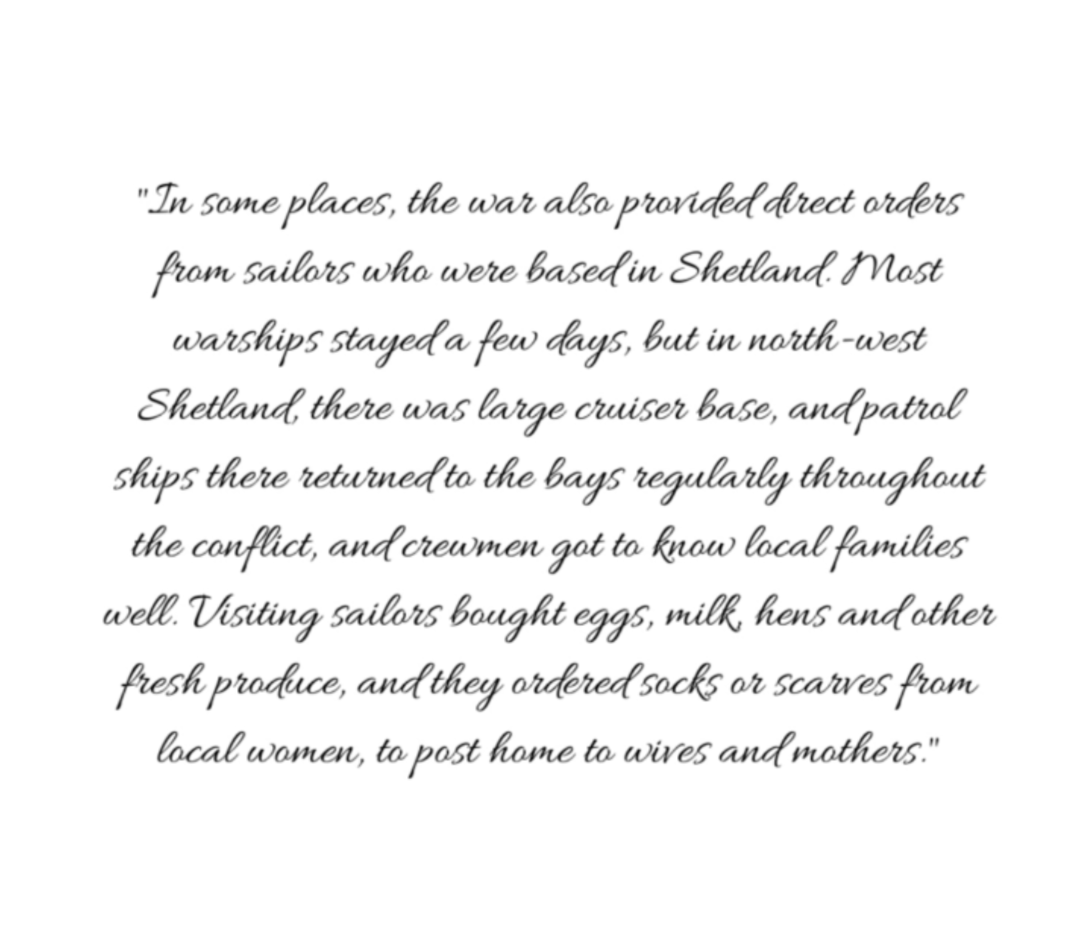Our boys need sox: How Shetland women knitted their way through the First World War (Part Three)
Over one hundred years have passed since the First World War was declared. Much of the coverage is often focused on the courage and bravery of the men who fought for King and country. The following is the final part of a three-piece research piece which I wrote a few years ago for the Wool Week Journal. It highlights the knitting that Shetland women did to aid the war effort. This essay will consider the economic impact of war on the knitwear industry in Shetland and conclude the last of these three in-depth pieces. If you missed part one and two, you can read them in my previous two blog posts.
Shetland women, as we discovered last week, made comfort packages containing non-perishable food items, tobacco, and clothing – especially knitted garments such as socks, scarves, balaclavas, cardigans and gloves.
Thomas Manson, the editor of the Shetland News, said that 'in this work, the women of Shetland set a magnificent example' determined 'to do all they could to make the lot of the sailors and soldiers more comfortable.'
An Economic activity?
The products that women produced for charitable purposes that we discussed in Part One and Part Two were manufactured to give away through local appeal committees; however, the war also brought economic prosperity for some. Increased naval activity around the isles meant that women were able to make some income from their knitwear; selling or bartering to visiting naval vessels.
James William Duncan from Burra recalls being sent out to the Royal Navy fleet in Cliff Sound to trade articles made by local women, including his mother. He said that the Navy men 'wid fill wis up wi stuff aff o da Navy boats – all sorts o stuff we were never seen afore: fruit an tobacco, all kind o things'.
Annie Pottinger, a mother of ten, married to the schoolteacher of Nesting, used the war to further her business interests. Mrs Pottinger ran her knitwear business from the Schoolhouse at Brettabister. Included in her price list from an advertising pamphlet for her business are 'Gent's Cravats (for airmen) – 4/6, 5/6, 7/6 each'. Mrs Pottinger was likely selling these garments to the airmen based a few miles away at the Royal Flying Corps base at Catfirth.
Shetland Museum curator, Dr Ian Tait says that:
This type of activity was commonplace in Shetland at that time; women would take their completed garments, such as socks and gloves and trade them at the local shop for commodities such as flour, tea and sugar. These wartime visitors were doing nothing that Shetland women had not been doing locally for generations.
The geographical location of Shetland lends itself well to cottage industries such as knitting. With a higher proportion of the population living in rural communities, on crofts, there was greater access to wool from their sheep which was then spun, plied and knitted into garments. Shetland women, at this time, could all knit, and this was what they did, wherever they went, whatever else they were doing, if their hands were free, they were knitting. Similarly, the vast majority learnt to knit at a very young age as Catherine Hodge (b. 1907) from Lerwick recalls:
Today, Shetland knitwear is world-famous for its construction, pattern, style and finish. However, it has not always been as highly acclaimed. A report submitted in 1914 to the Board for Agriculture on the Home Industries of the Highlands and Islands produced a scathing report on the Shetland knitwear industry.
Describing the quality of items sold by Shetland women as poor, with socks often sold at varying lengths. Part of the problem they believed, was the way in which people went about their knitting, which, ironically has produced some of the iconic imagery associated with Shetland knitting today of kishie-clad women knitting as they walk. The board continued that knitting 'is combined with some other occupation, and both are carried on simultaneously' with 'women knitting as they carry baskets of peats or engage in some other task connected with the croft'. In this way, Shetland women were easily placed to be able to continue the work of the croft while quickly churning out many thousands of pairs of socks, and, for the grateful soldiers, it is unlikely to have mattered if the left sock was longer than the right!
Photo: David Gifford
Despite this report, knitwear from Shetland was praised in a letter sent from St James' Palace, London (1916); it was described as 'beautifully knitted', and 'of the best quality'. They noted that they had gratefully received some 4,246 garments of this quality to date.
Another letter, sent to the Editor of Shetland News from R. Stuart Bruce of Edinburgh on behalf of the 9th Battalion (Highlanders) The Royal Scots, praises Shetland knitwear and the women who make it, he says:
The unique qualities of Shetland wool are particularly suited for the construction of knitted underwear and socks. As well as being warm and lightweight, it has elastic qualities so shapes itself around the body well. The bulk of the knitwear sent from Shetland was hand-knitted using Shetland wool. However, a quantity of yarn was sent from Scotland House in London, knitted into comforts and returned - with an additional 153 articles besides.
The national mania to knit comforts for troops was particularly suited to rural areas as these activities were practised as part of everyday life. Also, the resources and skills were already there, ready to be utilised and put to work. Therefore, of all regions in Britain, it is unsurprising that the contribution made by the women and girls of Shetland considerably outnumbered those from other areas, especially urban centres.
The crucial role women played is often overshadowed by the harrowing tales of servicemen; however, these contributions, at a very local level had a significant impact on the comfort of those serving overseas, and these women must be recognised and celebrated. Thomas Manson said that: 'When at last the time came for their work to cease they were able to point to a record of achievement which will stand as a lasting monument to their devotion and womanly sympathy with the men who were undergoing the most severe hardships and exposure'.
The knitting, carried out by Shetland women, keeping the home fires burning, was able to offer, if only briefly, a moment of comfort for many thousands of brave men fighting for King and country. In the knowledge that the women at home were behind them all the way, the men carried on.
Going through archive material demonstrates the scale of the work carried out, this, to me, shows how real the war felt to the people who remained in Shetland. The horrors of the First War escaped none.
One thing which is evident from researching these wartime knitters is that women from Shetland and throughout Britain felt an overwhelming desire to help, in any way they could. They recognised the horrors facing these men and wanted to do their bit and be of comfort to them, in some way. These thoughts are poignantly conveyed in the words of serviceman, poet and satirist, Siegfried Sassoon, who, in his poem, Glory of Women, he chillingly writes:
These words hit home hard, reminding us of the true reality of the war, and the fact that for many at home, they would never see their loved ones again.
Trench warfare has gone, and when I wrote this in 2014, I asked whether Shetland society would rally in the same way today. I can now answer that, and the answer is yes. The recent coronavirus pandemic has proven that Shetlanders are no less caring and giving. When the local hospital put out an appeal for scrubs, women across Shetland answered that call and set their sewing machines on full power, supplying our care staff in hospitals and homes around Shetland.
The platform on which war is staged has changed in the hundred or so years since the First World War. The First World War was one of national survival, and everyone defended a common cause. Today, people disagree over contemporary conflicts, and it's more common to take to the streets in protest rather than take up knitting wires. That said, the philanthropic nature which is embedded in Shetland still lives on. In times of crisis women still take up the wires and knit, and appeals driven by organisations such as the SWRI, born out of WWI, still make an impact on improving the lives and comfort of those overseas.
I'll close this final piece with a few lines from Nurse Martha Aitken; a Shetlander posted on the front line during the First World War. In a letter to her parents in 1915 she said that her heart went out to the injured soldiers and all the pain and suffering they endured; she wrote of the men, both British and German and said:
These are powerful and emotive words which I imagine sum up the thoughts harboured by these knitters who were carefully crafting garments for unknown men, who were, after all, somebody's boy.
This was the final in a three-part series; you can read Part One and Two here and here.
With love,
“Visitors want to have the best experience; they want to see Shetland through the eyes of a local. They want to taste the salt on their faces, smell the sea and bear witness to the wind in their hair. They want to drink in the sights, the smells and the sounds of an island community. They want to be shown the places they would otherwise not discover. They want to piece together the fascinating jigsaw and truly discover Shetland; this is the trip they have dreamed of.”










